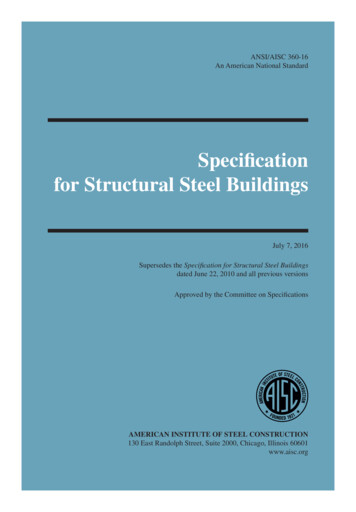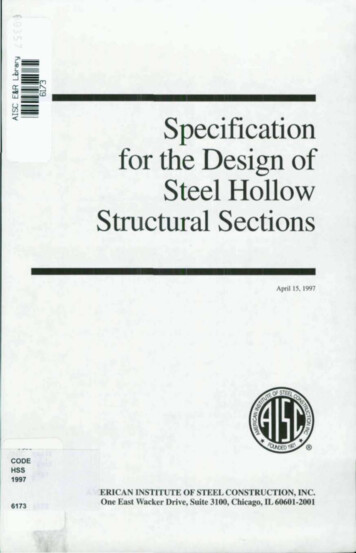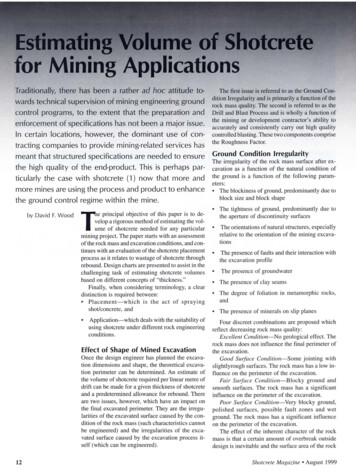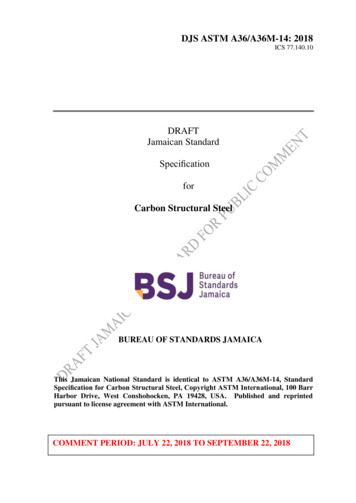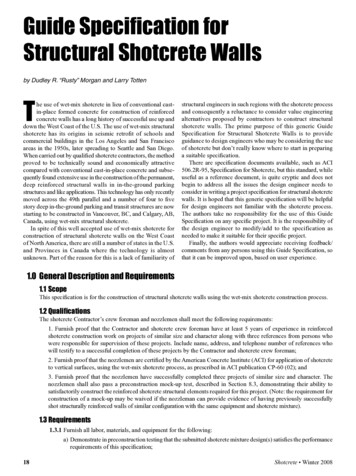
Transcription
Guide Specification forStructural Shotcrete Wallsby Dudley R. “Rusty” Morgan and Larry TottenThe use of wet-mix shotcrete in lieu of conventional castin-place formed concrete for construction of reinforcedconcrete walls has a long history of successful use up anddown the West Coast of the U.S. The use of wet-mix structuralshotcrete has its origins in seismic retrofit of schools andcommercial buildings in the Los Angeles and San Franciscoareas in the 1950s, later spreading to Seattle and San Diego.When carried out by qualified shotcrete contractors, the methodproved to be technically sound and economically attractivecompared with conventional cast-in-place concrete and subsequently found extensive use in the construction of the permanent,deep reinforced structural walls in in-the-ground parkingstructures and like appli cations. This technology has only recentlymoved across the 49th parallel and a number of four to fivestory deep in-the-ground parking and transit structures are nowstarting to be constructed in Vancouver, BC, and Calgary, AB,Canada, using wet-mix structural shotcrete.In spite of this well accepted use of wet-mix shotcrete forconstruction of structural shotcrete walls on the West Coastof North America, there are still a number of states in the U.S.and Provinces in Canada where the technology is almostunknown. Part of the reason for this is a lack of familiarity ofstructural engineers in such regions with the shotcrete processand consequently a reluctance to consider value engi neeringalternatives proposed by contractors to construct structuralshotcrete walls. The prime purpose of this generic GuideSpecification for Structural Shotcrete Walls is to provideguidance to design engineers who may be considering the useof shotcrete but don’t really know where to start in preparinga suitable specification.There are specification documents available, such as ACI506.2R-95, Specification for Shotcrete, but this standard, whileuseful as a reference document, is quite cryptic and does notbegin to address all the issues the design engineer needs toconsider in writing a project specification for structural shotcretewalls. It is hoped that this generic specification will be helpfulfor design engineers not familiar with the shotcrete process.The authors take no responsibility for the use of this GuideSpecification on any specific project. It is the responsibility ofthe design engineer to modify/add to the specification asneeded to make it suitable for their specific project.Finally, the authors would appreciate receiving feedback/comments from any persons using this Guide Specification, sothat it can be improved upon, based on user experience.1.0 General Description and Requirements1.1 ScopeThis specification is for the construction of structural shotcrete walls using the wet-mix shotcrete construction process.1.2 QualificationsThe shotcrete Contractor’s crew foreman and nozzlemen shall meet the following requirements:1. Furnish proof that the Contractor and shotcrete crew foreman have at least 5 years of experience in reinforcedshotcrete construction work on projects of similar size and character along with three references from persons whowere responsible for supervision of these projects. Include name, address, and telephone number of references whowill testify to a successful completion of these projects by the Contractor and shotcrete crew foreman;2. Furnish proof that the nozzlemen are certified by the American Concrete Institute (ACI) for application of shotcreteto vertical surfaces, using the wet-mix shotcrete process, as prescribed in ACI publication CP-60 (02); and3. Furnish proof that the nozzlemen have successfully completed three projects of similar size and character. Thenozzlemen shall also pass a preconstruction mock-up test, described in Section 8.3, demonstrating their ability tosatisfactorily construct the reinforced shotcrete structural elements required for this project. (Note: the requirement forconstruction of a mock-up may be waived if the nozzleman can provide evidence of having previously successfullyshot structurally reinforced walls of similar configuration with the same equipment and shotcrete mixture).1.3 Requirements1.3.1 Furnish all labor, materials, and equipment for the following:a) Demonstrate in preconstruction testing that the submitted shotcrete mixture design(s) satisfies the performancerequirements of this specification;18Shotcrete Winter 2008
b) Shoot a preconstruction mock-up of the reinforced shotcrete walls to demonstrate that the shotcrete materials,mixture(s), equipment, crew, and construction sequence and methods used are capable of producing a productconforming to these specifications and acceptable to the Engineer;c) Provide quality control services as necessary to ensure compliance of the completed work with the requirementsof this specification. Shoot test panels at the frequency specified for independent quality assurance testing bythe Engineer;d) Verify that the reinforcing steel bars in the walls are installed in a manner that is acceptable to the designEngineer and conducive to the shotcrete construction process;e) Provide all hoarding, covers, or other protection devices necessary to protect all fixtures and installations inthe shotcrete construction area from contamination or damage from the shotcrete construction process. Inparticular, protect such fixtures and installations from impact from the shotcrete nozzle stream, rebound,overspray, and shotcrete mist or dust;f) Provide all scaffolding, platforms, lift equipment, or other devices necessary to provide the shotcrete nozzlemenand other crew and inspectors with safe and proper access to the shotcrete work;g) Provide suitable ventilation, lighting, fans, curtains, or other devices necessary to provide the shotcretenozzlemen and crew with good visibility and control of shotcrete mist, dust, overspray, and rebound;h) Provide all forming, bracing, guide wires, and finishing tools necessary to enable construction of the reinforcedshotcrete elements to the specified profiles, tolerance, and finish;i) Apply shotcrete to the walls using prequalified nozzlemen and crew and approved shotcrete mixture(s);j) Finish shotcrete to specified finish, dimensions, tolerance, and line and grade. Provide moist curing andprotection as specified;k) Provide assistance to the Engineer for quality assurance testing including access for any coring required bythe Engineer. Remove and replace, at no cost to the Owner, any defective shotcrete or work that is nonconforming to the project specifications; andl) Leave completed shotcrete work in a clean condition, free of any deposits of excess shotcrete, overspray,rebound, or other contaminants. Remove all such materials from the work area and dispose of at an approveddisposal site.1.3.2 Implement a health, safety, and environmental protection program that conforms to the requirements of theEngineer and any other authorities having jurisdiction. Such programs shall include, but not be limited to the following:a) Ensure that all equipment, scaffolding, shoring, bracing, and other devices used on the project meet therequirements of the authorities having jurisdiction;b) Put in place a mandatory health and safety training program for all workers, inspectors, and other personsentering the workplace; andc) Protect all workers and other personnel from applied shotcrete and rebound during the shotcrete applicationprocess. As a minimum, all workers and personnel in active shotcreting areas shall wear appropriate respiratoryprotection devices as well as appropriate clothing and other personal protection equipment (hard hats, eyeprotection, safety boots, and reflective vests). Provide eye wash equipment at shotcrete site.2.0 Submittals2.1 Submit to the Engineer at least 10 working days before commencement of production of shotcrete work written documentation that provides the following:2.1.1 The qualifications of the Contractor and work crew, including the supervisor, shotcrete nozzleman, pump oper ator,and shotcrete blowpipe operators, and the references for the Contractor and shotcrete crew foreman required in 1.2 (a).2.1.2 Test records, showing source and proof of conformance to project specifications for all shotcrete materials, including:a) Portland cement;b) Supplementary cementing materials (silica fume and fly ash);c) Aggregates;d) Mixture water;e) Chemical admixtures; andf) Reinforcement.2.1.3 Details of proposed shotcrete mixture(s), proportions, and means of shotcrete supply.Shotcrete Winter 200819
2.1.4 A list of the proposed shotcreting equipment, including brand name, model, and capacity of proposed pump andair compressor.2.1.5 Results of the preconstruction testing program and a description of the proposed construction quality controltesting program, including the frequency of specific tests.2.1.6 Details of proposed scaffolding, man lifts, or other temporary support system for workers and inspectors.2.1.7 Details of proposed forming, bracing, or temporary support systems for construction of reinforced shotcreteelements.2.1.8 Details of proposed means of preparing surface to receive shotcrete.2.1.9 A description of proposed curing procedures and protection to be provided to shotcrete.2.1.10 Details of proposed methods for control and disposal of waste materials, including waste shotcrete, rebound,and overspray.3.0 Reference Documents3.1 The documents referenced in the following form a part of this document only to the extent referenced. In the case ofconflicts between the referenced portions of these documents and this specification, the requirements of this specificationtake precedence.3.1.1 American Concrete Institute (ACI)ACI 506R Guide to ShotcreteACI CP-60(02) Shotcrete Nozzlemen CertificationACI 506.2 Specifications for Shotcrete3.1.2 American Society for Testing and Materials (ASTM)ASTM C33 Specification for Concrete AggregatesASTM C94 Specification for Ready-Mixed ConcreteASTM C143 Test Method for Slump of Hydraulic-Cement ConcreteASTM C150 Specification for Portland CementASTM C231 Test Method for Air Content of Freshly Mixed Concrete by the Pressure MethodASTM C260 Standard Specification for Air Entraining Admixtures for ConcreteASTM C618 Specification for Coal Fly AshASTM C1140 Practice for Preparing and Testing Specimens from Shotcrete Test PanelsASTM C1141 Specification for Admixtures for ShotcreteASTM C1240 Specification for Silica Fume used in Concrete MixturesASTM C1436 Specification for Materials for ShotcreteASTM C1604 Test Method for Obtaining and Testing Drilled Cores of Shotcrete3.1.3 Canadian Standards Association (CSA) CSA A5 Portland CementCSA A23.5 Supplementary Cementing MaterialsCSA A23.1-04 Concrete Materials and Methods of Concrete ConstructionCSA A23.2-04 Methods of Test for Concrete4.0 Definitions4.1 The following definitions refer to words and terms used in this specification. For definitions not covered in this document,refer to ACI 506R and ACI 506.2.Acceptable, Approved or Permitted: Acceptable to approved or permitted by the Engineer.Bench gunning: The practice of shooting thick members of full section by building from the bottom up.Blowpipe: Air jet operated by nozzleman’s helper in shotcrete application to assist in keeping rebound and oversprayout of the work.Contractor: The person, firm, or corporation with whom the Owner enters into agreement for construction ofthe work.Engineer: The accepting authority responsible for issuing the project specifications and administering work under thecontract documents on behalf of the Owner.Guide wire (also called screed wire or shooting wire): Small gauge, high strength wire used to establish line and gradeto guide work.20Shotcrete Winter 2008
Nozzleman: Worker on the shotcrete crew who manipulates the nozzle, controls air addition at the nozzle, and controlsfinal deposition of the material.Overspray: Shotcrete material deposited away from the intended receiving surface.Rebound: Shotcrete material leaner than the original mixture that ricochets off the receiving surface and falls toaccumulate on the ground or other surfaces.Rod: Sharp-edged cutting screed used to trim shotcrete to forms or ground wires.Shadow: Area of porous, improperly consolidated shotcrete behind reinforcing steel or other embedements.Shotcrete: Concrete pneumatically projected at high velocity onto a receiving surface.Sloughing (also called sagging): Subsidence of shotcrete due generally to excessive water in the mixture or placingtoo great a thickness or height in a single pass.Wet-Mix Shotcrete: Shotcrete in which all the shotcrete ingredients, including mixture water, are mixed beforeintroduction into the shotcrete delivery system, and compressed air is introduced to the material flow at the nozzle.5.0 Materials5.1 Cement5.1.1 Cement shall conform to the requirements of ASTM C150 portland cement Type I, or CSA A5 portland cementType GU.5.2 Supplementary Cementing Materials5.2.1 Fly ash shall conform to the requirements of ASTM C618, Type F, or CAN/CSA-A3000-03 Type F or CI.5.2.2 Silica fume shall conform to the requirements of ASTM C1240, or CAN/CSA-A3000-03 Type SF.5.3 Water5.3.1 All water used in shotcrete production shall be of drinking water standard and free of oil and chemical ororganic impurities.5.3.2 Similarly, all water used in pressure sprayers for removal of rebound and overspray or green-cutting and forshotcrete curing shall be of drinking water standards and free of oil and chemical or organic impurities.5.4 Aggregates5.4.1 Use normalweight aggregates conforming to the requirements of ASTM C33 or CSA A23.1. Aggregates shallbe hard, dense, and durable and conform to limits for allowable quantities of deleterious substances as given inASTM C33 Tables 1 and 3 or CSA-A23.1-04 Table 12.5.4.2 Aggregates used shall not react with alkalies in the cement to an extent that results in excessive expansion of theshotcrete. The requirements of CSA A23.1-04 and CSA A23.2-27A shall be met.5.4.3 Use nominal 3/8 in. (10 mm) maximum size coarse aggregate combined with a concrete sand to provide a blendthat conforms to the following composite gradation envelope:U.S. sieve size1/2 in.3/8 in.No. 4No. 8No.16No. 30No. 50No. 100Metric sieve size14 mm10 mm5 mm2.5 mm1.25 mm630 µm315 µm160 µmTotal passing each sieve% by mass10090-10070-8550-7035-5520-358-202-105.4.4 The 3/8 in. to No. 8 (10 to 2.5 mm) coarse aggregate fraction shall be stockpiled and added separately from thefine aggregate (nominal No. 4 [5 mm] maximum size) during batching operations. (Note: in some jurisdictions 1/2 in.(12.7 mm) maximum size aggregate is now being used in thicker bench-gunned walls.)Shotcrete Winter 200821
5.5 Admixtures5.5.1 Do not use any admixtures containing chlorides. Do not use any shotcrete accelerators without written authorization by the Engineer.5.5.2 Air-entraining admixtures shall conform to the requirements of ASTM C260.5.5.3 Chemical admixtures, such as water reducers, high-range water reducers (superplasticizers), and retarders, shallconform to the requirements of ASTM C1141.5.6 Reinforcement5.6.1 Use reinforcing steel of the type, size, and dimensions shown in the drawings.6.0 Shotcrete Proportioning6.1 Mixture Design6.1.1 The Contractor shall be responsible for shotcrete mixture proportioning. Submit the proposed shotcrete mixtureproportions to the Engineer for review and approval at least 10 working days before preconstruction trials; see Section8.3. As a minimum, for each shotcrete mixture design, submit the following information:a) An easily identifiable mixture designation, number, or code; andb) Proof that the proposed mixture design is capable of meeting the specified performance requirements.6.1.2 Performance RequirementsProportion shotcrete to meet the following performance requirements:Test descriptionTest methodMaximum water/cementitious materials ratioAge(days)Specifiedrequirement—0.454 1%2 1/2 1 in.(60 20 mm)Air content – as shot1,2ASTM C231, or CSA A23.2-4C—Slump at discharge into pumpASTM C143, or CSA A23.2-5C—ASTM C1604, or CSA A23.2-14C728Minimum compressive strength, psi (MPa)2900 psi (20MPa)34350 psi (30 MPa)3Note 1: To obtain an as-shot air content of 4 1% will require an air content at the point of discharge into the shotcrete pump in the 7 to 10% range.Note 2: The use of air entrainment is beneficial even in shotcrete not exposed to freezing and thawing because, as air content is lost on shooting,there is a corresponding loss of slump on impact that helps prevent sagging and sloughing.Note 3: Some authorities require shotcrete cores extracted from test panels (or the in-place shotcrete) to only meet 85% of the specified strength,as is often done for concrete cores. If this is the requirement for the project, then this should be clearly stated in the project specification. Otherwise,the minimum specified compressive in the previous table prevails.Note 4: The Engineer may specify higher compressive strengths if structurally required.7.0 Supply and Equipment7.1 Batching, Mixing, and Supply7.1.1 Batch, mix, and supply wet-mix shotcrete by one of the following methods:a) Central mixing with transit mixture delivery; orb) Transit mixing and delivery.7.1.2 Central Mixing and Supplya) Aggregate, cement, and silica fume shall be mass batched in a central mixer in accordance with the requirementsof ASTM C94 or CSA A23.1-04. Water and chemical admixtures shall be batched to the accuracy specifiedin ASTM C94 or CSA A23.1-04;b) Transit mixers shall be free of excessive accumulations of hardened shotcrete or concrete in the drum or onthe blades. Blades shall be free of excessive wear. Transit mixture delivery shall conform to the requirementsof ASTM C94 or CSA A23.1-04; andc) All shotcrete shall be shot within 90 minutes after addition of mixture water to the batch. Shotcrete loads shallbe of such batch size that this requirement is met. This time limit may be extended, subject to approval by the22Shotcrete Winter 2008
Engineer, if proper use is made of set retarding or hydration controlling admixtures to maintain workabilitywithout retempering with water.7.1.3 Transit Mixing and SupplyThe same requirements in Section 7.1.2 apply for central mixing except that all ingredients shall be added directly tothe transit mixer instead of the central mixer. Transit mixers shall be charged to not more than 70% of their ratedcapacity, to enable efficient mixing action.7.2 Shotcrete Placing Equipment7.2.1 The shotcrete delivery equipment shall be capable of delivering a steady stream of uniformly mixed material tothe discharge nozzle at the proper velocity and rate of discharge.7.2.2 The use of positive displacement pumps equipped with hydraulic or mechanically powered pistons (for example,similar to conventional concrete piston pumps), with compressed air added at the discharge nozzle, is the preferredtype of wet-mix shotcrete delivery system. Pneumatic feed guns, rotary type feed guns (similar to dry-mix guns) andperistaltic squeeze-type pumps shall only be used if the Contractor can demonstrate that they produce shotcrete meetingall the specified performance requirements.7.2.3 The air ring at the nozzle shall be carefully monitored for any signs of blockage of individual air holes. If nonuniform discharge of shotcrete becomes apparent, shooting shall be stopped and the air ring cleaned or other appro priatecorrective actions taken.7.2.4 The delivery of equipment shall be thoroughly cleaned at the end of each shift. Any build-up of coatings in the deliveryhose and nozzle shall be removed. The air ring and nozzle shall be regularly inspected and cleaned, and replaced if required.7.3 Auxiliary Shotcrete Equipment7.3.1 Supply clean, dry, compressed air, capable of maintaining sufficient nozzle velocity for all parts of the work andsimultaneous operation of a blowpipe.7.3.2 The air supply system shall contain a moisture and oil trap to prevent contamination of the shotcrete.7.3.3 Provide auxiliary shotcrete equipment such as material delivery hoses, blowpipes, and couplings as required tocomplete the work.7.4 Reinforcing Steel7.4.1 Reinforcing steel to be of the type, size, and dimensions detailed in the drawings.7.4.2 Securely tie reinforcing steel bars at locations of intersecting bars with 0.06 in. (1.6 mm) or heavier gauge tiewire to minimize vibration and prevent movement of steel during shotcrete application. Avoid formation of knots oftie wire that could interfere with proper shotcrete encasement of reinforcing steel.7.4.3 Tie reinforcing steel to avoid multiple laps or other congestion that could compromise ability of shotcrete nozzlemanto properly encase reinforcing steel and embedments.7.4.4 Submit proposed splice details to the Engineer for review and approval before installation of reinforcing steel.7.4.5 Clearance between reinforcing bars and formwork or substrate to be as detailed in drawings, but not less than0.79 in. (20 mm).7.5 Alignment Control and Cover7.5.1 Implement alignment control to establish control over line and grade and ensure that the minimum specifiedshotcrete thickness and cover to reinforcing steel are maintained. Verify that reinforcing bars are fixed to providespecified cover before application of any shotcrete.7.5.2 Provide alignment control by means of devices such as shooting wires, guide strips, depth gauges, or forms. Theproposed means of alignment control shall be submitted to the Engineer for review and approval before any shotcreteapplication.7.5.3 When ground wires (also called guide wires or shooting wires) are used, they shall consist of a high-strengthsteel wire kept taut during shotcreting. Remove ground wires after completion of shotcreting and screeding operations.7.5.4 Guide strips and forms shall be of such dimensions and installation configuration that they do not impede theability of the nozzlemen to produce uniform, dense, properly consolidated shotcrete. In particular, installations thatare conducive to the entrapment of rebound or formation of shadows and voids shall not be used.Shotcrete Winter 200823
8.0 Quality Assurance and Quality Control8.1 Quality AssuranceThe Engineer will implement a quality assurance program, paid for by the Owner, which will include:a) Review of Contractor Submittals;b) Review and approval of Contractor’s proposed materials, supplies, equipment, and crew. In particular, all shotcretenozzlemen proposed for use on the project shall be evaluated in the preconstruction mock-up testing program. Onlynozzlemen approved by the Engineer shall be used on the project;c) Examination and approval of areas prepared for shotcreting at start-up of the project, including installation ofanchors, reinforcement, and devices to control line and grade before application of any shotcrete;d) Provision of intermittent inspections to monitor shotcrete installation at a frequency selected by the Engineer;e) Regular monitoring of the results of the compressive strength tests conducted by a testing agency appointed andpaid for by the Owner on cores extracted from standard shotcrete test panels shot by the Contractor at a frequencyspecified by the Engineer;f) Implementation of a program for in-place evaluation and acceptance, or rejection, where testing indicates shotcreteis nonconforming to the project specifications;g) Where defective shotcrete is indicated, carrying out appropriate tests that may include core evaluation and compressivestrength testing of extracted cores from the in-place shotcrete; andh) Monitoring of a program of remedial works by the Contractor, where indicated as being necessary from the resultsof the quality assurance program.8.2 Quality ControlThe Contractor shall establish and maintain a quality control program for the shotcrete work to ensure compliance withthe contract requirements. Such program shall include maintenance of test records for all quality control operations. Suchrecords shall be provided to the Engineer for review on request.8.3 Preconstruction Trials8.3.1 Implement a preconstruction trial to enable the Engineer to evaluate the ability of the proposed materials, shotcretemixture, equipment, and crew to produce shotcrete conforming to the project specifications. Acceptance of thepreconstruction trial results by the Engineer is required before application of any shotcrete on the project.8.3.2 The preconstruction trial shall be used to prequalify the nozzlemen proposed for use on the project. Nozzlemenwho have not been prequalified shall not be permitted to apply shotcrete on the project.8.3.3 The preconstruction trial shall use the same materials, shotcrete mixture, and equipment proposed for use on theproject and approximate actual working conditions, configuration, reinforcement, and shooting positions as near as possible.8.3.4 Nozzlemen shall prequalify by shooting mock-ups of the reinforced structural wall element. Five cores shall betaken from each mock-up for core grading from locations directed by the Engineer.8.3.5 Cores shall be evaluated by the Engineer to check the quality of shotcrete placement. Cores shall show adequateconsolidation and be free of excessive voids around reinforcing steel, shadows, sags, sloughing, or delaminations.8.3.6 Prequalify the shotcrete mixture by shooting a plain (nonreinforced) test panel with dimensions of 18 x 18 x4.5 in. (450 x 450 x 110 mm) deep. The test panel shall be made from wood and sealed plywood and have 45-degreesloped edges to permit rebound to escape and facilitate demoulding.8.3.7 Cure the test panels in the field, close to the location where shot, for two (2) days before being transported in theform to the testing laboratory. Cure the test panel under wet burlap covered with plastic sheet under temperaturesconditions similar to that experienced by the wall. Protect the panels from disturbance or damage.8.3.8 Assist testing laboratory by loading test panels, in their forms, onto their trucks. Test panels and cores extractedfrom the test panels shall be moist cured in the laboratory at 73.4 2 F (23 2 C) until the time of compressivestrength testing.8.3.9 If the preconstruction test specimens fail to meet the project performance requirements, then make the necessaryadjustments in shotcrete materials, mixture design, or application, and reshoot test panels. No work shall commenceon the project until the preconstruction performance testing requirements have been meet.8.4 Construction Testing8.4.1 Shoot one construction test panel for each 65 yd3 (50 m3) of shotcrete production, or for each day of shotcreteproduction, whichever is more frequent. Shoot the panel in the same orientation as the work being done.24Shotcrete Winter 2008
8.4.2 Produce, store, handle, and cure construction test panels in the same manner prescribed for preconstruction testpanels. Similarly, prepare, handle, cure, and test shotcrete in the same manner prescribed for the preconstruction test panels.9.0 Shotcrete Application and Finishing9.1.1 Provide suitable scaffolding, man lifts, or other devices to provide the nozzlemen, helpers, and inspectors withfree unhindered access to the work area. Provide safety measures to protect the workers on such devices that complywith the requirements of the authorities having jurisdiction.9.1.2 Install sufficient lighting and ventilation to provide the nozzlemen and helpers with a clear, unhindered viewof the shooting area. Work shall be terminated and corrective measures adopted if, in the opinion of the Engineer,visibility is unsuitable for the safe application of quality shotcrete.9.1.3 Use good shotcrete nozzling technique as detailed in ACI 506R-05. In particular:a) Use the bench-gunning technique. Orient the nozzle at right angles to the receiving surface, except as requiredto fill corners, cove edges, and encase reinforcing steel;b) Optimize the combination of air volume at the nozzle and distance of the nozzle from the receiving surfaceto achieve maximum consolidation of the shotcrete and full encapsulation of the reinforcing steel;c) Adjust air volume and distance of the nozzle from the work while encasing reinforcing steel to keep the frontface of the reinforcement clean during shooting operations, so that shotcrete builds up from behind to encasethe reinforcement without the formation of shadows or voids;d) Nozzleman’s helper to continuously remove accumulations of rebound and overspray using blowpipe, orother suitable devices in advance of deposition of new shotcrete; ande) Do not include rebound, hardened overspray, or stiffened shotcrete trimmings in the shotcrete work.9.2 When applying more than one layer of shotcrete trim with a cutting rod, or brush with a stiff bristle broom to removeall loose material, overspray, laitance, or other material detrimental to bonding of the next layer of shotcrete.9.3 Allow shotcrete layer to stiffen sufficiently before applying next layer of shotcrete. If shotcrete has set and hardened,high-pressure water blast (minimum 5000 psi [34.4 MPa]) with clean water and bring to a saturated surface-dry (SSD)condition at time of application of the next layer of shotcrete. Use air blow pipe to accelerate drying if necessary.9.4 Use a shooting technique that provides full encapsulation of all reinforcing steel and embedments. Cut out any voids,shadows, sags, or other defects from the applied shotcrete while still plastic and reshoot. Otherwise make good any defectsin the hardened shotcrete using light-duty chipping hammers (15 lb [7 kg] maximum) followed by high pressure waterblasting (minimum 5000 psi [34.4 MPa]) to remove bruised shotcrete surface.9.5 Trim shotcrete with a cutting rod or other suitable device to the specified line and grade. Finish shotcrete to a sandytexture as approved by the Engineer using suitable finishing tools. Tolerance of finished surface shall be as specified bythe Engineer.9.6
20 Shotcrete Winter 2008 2.1.4 A list of the proposed shotcreting equipment, including brand name, model, and capacity of proposed pump and air compressor. 2.1.5 Results of the preconstruction testing program and a description of the proposed construction quality control testing program, including the frequency of specific tests. 2.1.6 Details of proposed scaffolding, man lifts, or other .

